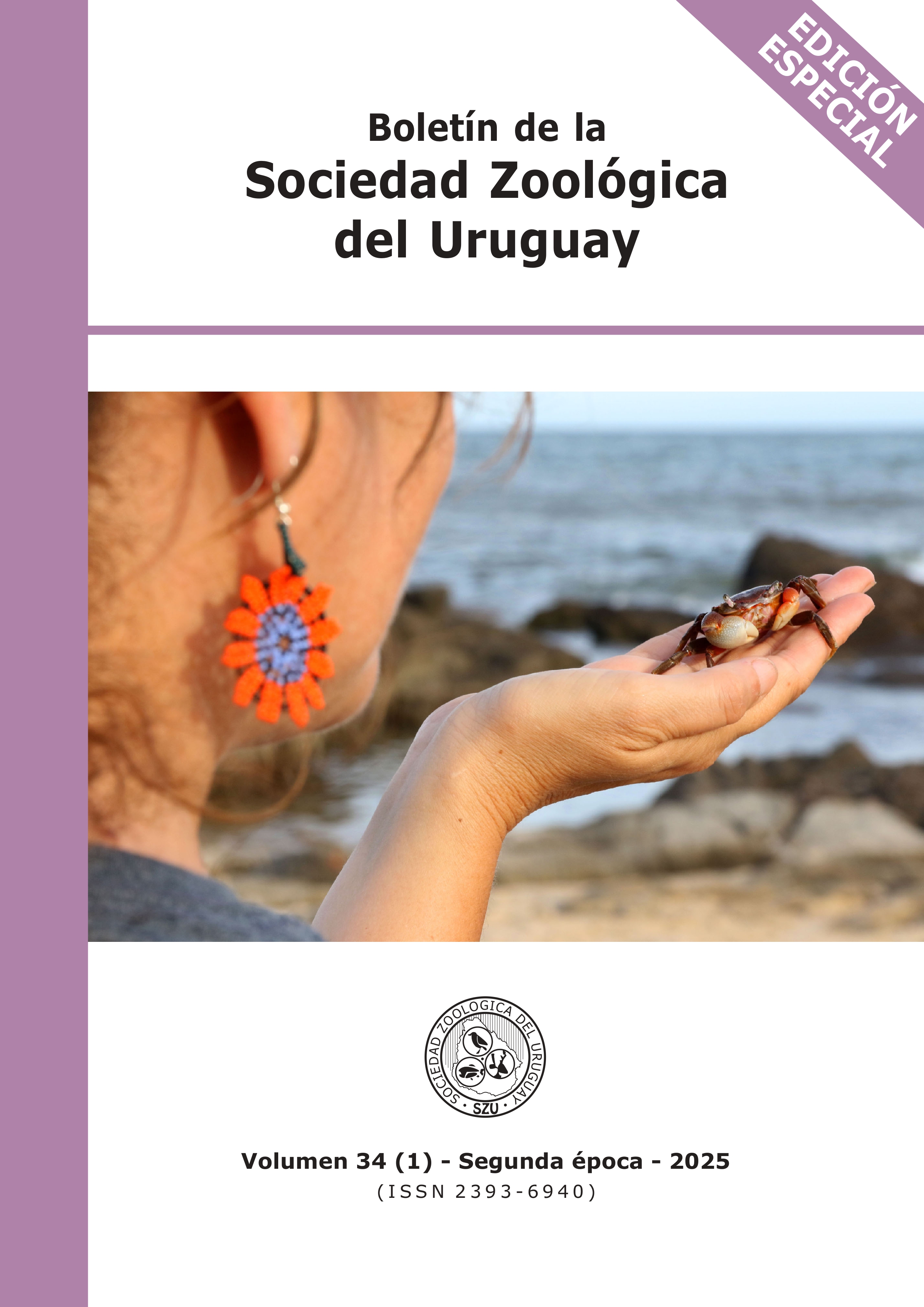TEJIENDO HISTORIAS: LA CIENCIA DETRÁS DEL ESTUDIO DE LAS MIGALOMORFAS DE ARGENTINA
DOI:
https://doi.org/10.26462/34.1.20Palabras clave:
metodología, araña, estudios integrativos, modelos de estudioResumen
Las arañas migalomorfas (infraorden Mygalomorphae) constituyen un grupo con una rica historia evolutiva, amplia variedad de modos de vida y adaptaciones ecológicas singulares, lo que las convierte en excelentes modelos de estudio. Desde 2006, hemos abordado el estudio de las migalomorfas en diferentes áreas como la taxonomía, sistemática, biogeografía, comportamiento, ecología e historia natural. Este ensayo reúne las metodologías empleadas en nuestras investigaciones, que incluyen la obtención de especímenes, trabajos de campo y la implementación de análisis cladísticos basados en caracteres morfológicos, complementados con herramientas moleculares para esclarecer relaciones evolutivas complejas. También abordamos estudios sobre biología reproductiva, comportamiento y ecología, los cuales han permitido una comprensión más profunda e integral de la relación de las migalomorfas con el entorno. Estos avances no sólo enriquecen el conocimiento sobre la biodiversidad del grupo, sino que también contribuyen a su conservación y al desarrollo de proyecciones sobre las especies conocidas y aún por descubrir.
Descargas
Citas
Aguirre Morales, A., Millenpeier, M., Signorotto, F., Guerra, C., & Ferretti, N. (2022). Interacciones intra e interespecíficas de juveniles de dos especies de tarántulas simpátricas de Sierra de la Ventana (Buenos Aires, Argentina). Libro de resúmenes III Jornadas Argentinas de Aracnología, Bahía Blanca, pp. 53.
Allegue, M., Schwerdt, L., & Ferretti, N. (2024). Conservation biogeography and diversity of tarantulas in Argentina. Biological Journal of the Linnean Society, blae002. https://doi.org/10.1093/biolinnean/blae002
Ausserer, A. (1875). Zweiter Beitrag zur Kenntniss der Arachniden-Familie der Territelariae Thorell (Mygalidae Autor). Verhandlungen der Kaiserlich-Königlichen Zoologisch-Botanischen Gesellschaft in Wien, 25, 125-206.
Barrett, R.D.H., & Hebert, P.D.N. (2005). Identifying spiders through DNA barcodes. Canadian Journal of Zoology, 83(3), 481-491. https://doi.org/10.1139/z05-024
Briggs, E.J., & Hamilton, C.A. (2024). What does the history of Theraphosidae systematics tell us about the future of tarantula taxonomy? Frontiers in Arachnology Science, 3, 1445731. https://doi.org/10.3389/frchs.2024.1445731
Capocasale, R.M., Perez-Miles, F., Costa, F.G., Gudynas, E., & Prandi, L. (1989). Comunicación preliminar sobre la aracnofauna criptozoica de Sierra de las Ánimas, Uruguay. Boletín de la Sociedad Zoológica del Uruguay, 5, 31-32.
Catálogo de Arañas de Argentina (2024). Catálogo de Arañas de Argentina. Museo Argentino de Ciencias Naturales "Bernardino Rivadavia", https://sites.google.com/site/catalogodearanasdeargentina/, consultado 3 octubre 2024.
Cavallo, P., & Ferretti, N. (2015). The first Hapalotremus Simon, 1903 (Araneae: Theraphosidae) from Argentina: description and natural history of Hapalotremus martinorum new species. Journal of Natural History, 49, 873-887.
Copperi, S., Ferretti, N., & Pompozzi, G. (2012). Can't you find me? Female sexual response in an Argentinean tarantula (Araneae, Theraphosidae). Revista Colombiana de Entomología, 38, 164-166.
Díaz, M., Concepción, E.D., Morales, M.B., Alonso, J.C., Azcárate, F.M., Bartomeus, I., ... & Velado-Alonso, E. (2021). Environmental objectives of Spanish agriculture: Scientific guidelines for their effective implementation under the Common Agricultural Policy 2023-2030. Ardeola, 68(2), 445-460.
Ferretti, N. (2015a). Cladistic reanalysis and historical biogeography of the genus Lycinus Thorell, 1894 (Araneae: Mygalomorphae: Nemesiidae) with description of two new species from western Argentina. Zoological Studies, 51, 1-15.
Ferretti, N. (2015b). A new species of Phrixotrichus (Araneae, Theraphosidae) from southwestern Argentina and new distributional data for P. vulpinus. Iheringia, Série Zoologia, 105(2), 252-256. https://doi.org/10.1590/1678-476620151052252256
Ferretti, N., & Barneche, J. (2012). New species of Eupalaestrus from Argentina (Araneae, Theraphosidae, Theraphosinae). Iheringia. Série Zoologia, 102, 327-330.
Ferretti, N., & Barneche, J. (2013). Description of two new species of Plesiopelma (Araneae, Theraphosidae, Theraphosinae) from Argentina. Iheringia. Série Zoologia, 103, 374-380.
Ferretti, N., Pompozzi, G., & Pérez-Miles, F. (2011). Sexual behavior of Acanthogonatus centralis (Araneae: Mygalomorphae: Nemesiidae) from Argentina, with some notes on their burrows. Journal of Arachnology, 39, 533-536.
Ferretti, N., Copperi, S., Schwerdt, L., & Pompozzi, G. (2014). Another migid in the wall: natural history of the endemic and rare spider Calathotarsus simoni (Mygalomorphae: Migidae) from a hill slope in central Argentina. Journal of Natural History, 48(31-32), 1907-1921.
Ferretti, N., González A. & Pérez-Miles, F. (2012a). Historical biogeography of mygalomorph spiders from the peripampasic orogenic arc based on track analysis and PAE as a panbiogeographical tool. Systematics and Biodiversity, 10(2), 179-193.
Ferretti, N.E., González, A., & Pérez Miles, F. (2012b). Historical biogeography of the genus Cyriocosmus (Araneae: Theraphosidae) in the Neotropics according to an event-based method and spatial analysis of vicariance. Zoological Studies, 51(4), 526-535.
Ferretti, N.E., & Pompozzi, G. (2012). Grammostola vachoni. En: IUCN 2012. IUCN Red List of Threatened Species. Version 2012.2. .
Ferretti, N., Pompozzi, G., Copperi, S., González, A., & Pérez-Miles, F. (2013a). Sexual behavior of mygalomorph spiders: when simplicity becomes complex, an update of the last 21 years. Arachnology, 16, 85-93.
Ferretti, N., Pompozzi, G., Copperi, S., & Schwerdt, L. (2013b). Aerial dispersal by Actinopus spiderlings (Araneae: Actinopodidae). Journal of Arachnology, 41, 407-408.
Ferretti, N., Pompozzi, G., González, A., & Pérez-Miles, F. (2013c). The genus Grammostola Simon 1892 (Araneae: Theraphosidae): a new species from western Argentina, new synonymy and distributional data. Journal of Natural History, 47(47-48), 2961-2977.
Ferretti, N., Copperi, S., & Schwerdt, L. Pompozzi, G., (2015a). First record of Vitalius longisternalis Bertani, 2001 (Araneae, Theraphosidae) in Argentina and notes on its natural history in Misiones province. Check List, 11, 1-5.
Ferretti, N., Copperi, S., Schwerdt, L., & Pompozzi, G. (2015b). First record of Vitalius roseus (Mello- Leitão, 1923) (Araneae: Theraphosidae: Theraphosinae) in Argentina: distribution map, natural history and sexual behavior. Arachnology, 16, 241-243.
Ferretti, N., Nime, M., & Mattoni, C. (2017a). Three new Idiops (Mygalomorphae: Idiopidae) from Argentina and redescription of the male of I. hirsutipedis Mello-Leitão, 1941. Journal of Natural History, 51(17-18), 975-994.
Ferretti, N., Pompozzi, G., & Cardoso, P. (2017c). Species conservation profile of the rare and endemic trapdoor spider Calathotarsus simony (Araneae, Migidae) from Central Argentina. Biodiversity Data Journal 5: e14790, doi:10.3897/BDJ.5.e14790
Ferretti, N., Pompozzi, G., Copperi, S., Wehitt, A., Galíndez, E., González, A., & Pérez-Miles, F. (2017b). A comparative morphological study of the epiandrous apparatus in mygalomorph spiders (Araneae, Mygalomorphae). Micron, 93, 9-19.
Ferretti, N.E., Arnedo, M., & González, A. (2018). Impact of climate change on spider species distribution along the La Plata River basin, southern South America: projecting future range shifts for the genus Stenoterommata (Araneae, Mygalomorphae, Nemesiidae). Annales Zoologici Fennici, 55(1-3), 123-133.
Ferretti, N., Soresi, D., González, A., & Arnedo, M. (2019). An integrative approach unveils speciation within the threatened spider Calathotarsus simoni Schiapelli y Gerschman, 1975 (Araneae: Mygalomorphae: Migidae). Systematics and Biodiversity, 17(7), 617-632.
Ferretti, N., Guerra, C., Panchuk, J., & Nicoletta, M. (2023a). Slow science renaissance: Understanding the ecology, natural history and demography of a highly endemic mygalomorph spider from Argentina. XXII International Congress of Arachnology, Montevideo.
Ferretti, N., Panchuk, J., & Nicoletta, M. (2023b). Unexpected diversity: The mygalomorph spider community from a natural reserve representing the dry Chaco region in Argentina. XXII International Congress of Arachnology, Montevideo.
Ferretti, N., Nicoletta, M., & Soresi, D. (2024). An integrative taxonomy approach evaluates the limits of the widespread tarantula Plesiopelma longisternale (Araneae: Mygalomorphae: Theraphosidae) and reveals a new species from Argentina. Zoologischer Anzeiger, 308, 131-143.
Gertsch, W.J. & Platnick, N.I. (1979). A revision of the spider family Mecicobothriidae (Araneae, Mygalomorphae). American Museum Novitates, 2687, 1-32.
Goloboff, P.A. (1995). A revision of the South American spiders of the family Nemesiidae (Araneae, Mygalomorphae). Part I: species from Peru, Chile, Argentina, and Uruguay. Bulletin of the American Museum of Natural History, 224, 1-189.
Goulet, C.T., Thompson, M.B., Michelangeli, M., Wong, B.B., & Chapple, D.G. (2017). Thermal physiology: A new dimension of the pace of life syndrome. Journal of Animal Ecology, 86(5), 1269-1280.
Grismado, C.J., & Goloboff, P.A. (2014). Mecicobothriidae, Hexathelidae y Dipluridae. In Roig-Juñent, S., Claps, L.E. & J.J. Morrone (eds.) Biodiversidad de Artrópodos Argentinos, vol. 3. Sociedad Entomológica Argentina, pp. 95-101.
Hamilton, C.A., Formanowicz, D.R., & Bond, J.E. (2011). Species delimitation and phylogeography of Aphonopelma hentzi (Araneae, Mygalomorphae, Theraphosidae): cryptic diversity in North American tarantulas. PloS ONE, 6(10), e26207. https://doi.org/10.1371/journal.pone.0026207.
Holmberg, E.L. (1876). Arácnidos argentinos. Anales de Agricultura de la República Argentina,4, 1-30.
Holzmann, I., Agostini, I., DeMatteo, K., Areta, J.I., Merino, M.L., & Di Bitetti, M.S. (2014). Using species distribution modeling to assess factors that determine the distribution of two parapatric howlers (Alouatta spp.) in South America. International Journal of Primatology, 36(1), 18-32.
Informe del estado del ambiente. (2020). Federico Martinez Waltos.Primera edición. Ciudad Autónoma de Buenos Aires: Ministerio de Ambiente y Desarrollo Sostenible de la Nación, 2021 (https://www.argentina.gob.ar/sites/default/files/iea_2020_digital).
IPCC (2023) En Lee H., Romero J. (eds) Climate Change 2023: synthesis report. Contribution of Working groups I, II and III to the Sixth Assessment Report of the Intergovernmental Panel on Climate Change [Core writing Team. IPCC, Geneva, Switzerland, pp 35-115.
Izquierdo, M.A., Dederichs, T.M., Cargnelutti, F., & Michalik, P. (2023). Copulatory behaviour and genital mechanics suggest sperm allocation by a non-intromittent sclerite in a pholcid spider. Royal Society Open Science, 10(5), 230263.
Kralj-Fišer, S., & Schuett, W. (2014). Studying personality variation in invertebrates: why bother? Animal Behaviour, 91, 41-52.
Main, B.Y. (1987). Persistence of invertebrates in small areas: case studies of trapdoor spiders in Western Australia. In D.A. Saunders, G.W. Arnold, A.A. Burbidge, y A.J.M. Hopkins (Eds.), Nature conservation: The role of remnants of native vegetation (pp. 29-39). Surrey Beatty and Sons.
Mason, L.D., Wardell-Johnson, G., & Main, B.Y. (2018). The longest-lived spider: mygalomorphs dig deep, and persevere. Pacific Conservation Biology, 24(2), 203-206.
Mason, L.D., Wardell-Johnson, G., & Main, B.Y. (2022). Persistence of Stasimopus trapdoor spiders in fragmented landscapes of the southern African savannah. Journal of Biogeography, 49(6), 1113-1126. https://doi.org/10.1111/jbi.14337
Mello-Leitão, C.F. (1939). Araignées américaines du Musee d'histoire naturelle de Bâle. Revue Suisse de Zoologie, 46(2), 43-93.
Mendoza, J. (2020). Situation and conservation of tarantulas in the Americas. In F. Pérez-Miles (Ed.), New World tarantulas: Taxonomy, Biogeography and Evolutionary Biology of Theraphosidae (pp. 463–495). Springer.
Michelangeli, M., Goulet, C.T., Kang, H.S., Wong, B.B., & Chapple, D.G. (2018). Integrating thermal physiology within a syndrome: Locomotion, personality, and habitat selection in an ectotherm. Functional Ecology, 32(4), 970-981.
Millenpeier, M., Ferretti, N., & Nicoletta, M. (2023). Description of the female of Actinopus balcarce Ríos-Tamayo y Goloboff, 2018 (Araneae, Actinopodidae), with comments on its natural history. Journal of Insect Biodiversity and Systematics, 9, 809-817.
Ministerio de Ambiente y Desarrollo Sostenible de la Nación (2020). Programa de Acción Nacional de lucha contra la desertificación, degradación de tierras y mitigación de la sequía: actualizado a la meta 2030 (https://www.argentina.gob.ar). Newton, L.G., Starret, J., Hendrixson, B.E., Derkarabetian, S. & Bond, J.E. (2020). Integrative species delimitation reveals cryptic diversity in the southern Appalachian Antrodiaetus unicolor (Araneae: Antrodiaetidae) species complex. Molecular Ecology, 29, 2269-2287.
Nicoletta, M. (2021). Taxonomía y distribución de las arañas albañiles del género Actinopus Perty, 1833 (Araneae: Actinopodidae) en el sur de la provincia de Buenos Aires, Argentina, con la descripción de una nueva especie. Tesis de grado. Universidad Nacional del Sur, Bahía Blanca, Argentina.
Nicoletta, M., & Ferretti, N. (2022). ¿Por qué no hay picnotélidos (Araneae, Pycnothelidae) en Tandilia? Una aproximación desde el modelado de distribución. XIV Reunión Argentina de Cladística y Biogeografía, Trelew.
Opatova, V., Hamilton, C.A., Hedin, M., Montes de Oca, L., Král, J., & Bond, J.E. (2020). Phylogenetic systematics and evolution of the spider infraorder Mygalomorphae using genomic scale data. Systematic Biology, 69(4), 671-707.
Panchuk, J., & Ferretti, N. (2018). Surface soil type preference for burrowing of the endangered and endemic trapdoor spider Calathotarsus simony (Araneae: Migidae). Arachnology, 17(8), 364-366.
Panchuk, J., & Ferretti, N. (2022). A first comprehensive ecological approach on the highly endemic mygalomorph spider Mecicobothrium thorelli (Araneae: Mecicobothriidae): Understanding life history traits to address future conservation issues. Journal of Natural History, 56, 49-66.
Panchuk, J., Schwerdt, L., & Ferretti, N. (2023). Differences between thermal preference and thermal performance in a wintry spider Mecicobothrium thorelli: are the spiders under evolutionary pressures on their seasonal activity? Canadian Journal of Zoology, 101(12), 1093-1100. https://doi.org/10.1139/ cjz-2023-0059
Panchuk, J., Ferretti, N., Poy, D., Ramírez, M.J., & Michalik, P. (2024). Genital directional asymmetry and copulatory mechanics in Mecicobothrium thorelli (Araneae, Mecicobothriidae). Libro de Resúmenes VII Congreso Latinoamericano de Aracnología, Colombia, pp. 20-21.
Phillips, S.J., Anderson, R.P., & Schapire, R.E. (2006). Maximum entropy modeling of species geographic distributions. Ecological Modelling, 190(3-4), 231-259.
Poy, D., Piacentini, L.N., Lin, S.W., Martínez, L.A., Ramírez, M.J., & Michalik, P. (2023). Copulatory mechanics of ghost spiders reveals a new self bracing mechanism in entelegyne spiders. Ecology and Evolution, 13(10), e10582.
Poy, D., Ramírez, M.J., Michalik, P., & Piacentini, L.N. (2020). Copulatory mechanics in the wolf spider Agalenocosa pirity reveals a hidden diversity of locking systems in Lycosidae (Araneae). Journal of morphology, 281(2), 250-257.
Ríos-Tamayo, D. & Goloboff, P.A. (2018). Taxonomic revision and morphology of the trapdoor spider genus Actinopus (Mygalomorphae: Actinopodidae) in Argentina. Bulletin of the American Museum of Natural History, 419, 1-83.
Sadana, G.L. (1972). Mechanics of copulation in Lycosa chaperi Simon (Araneida: Lycosidae). Bulletin of the British Arachnological Society, 2(5), 87-89.
Sanmartín, I. (2012). Historical biogeography: Evolution in time and space. Evolution: Education and Outreach, 5(4), 555-568.
Santos, C.M.D., & Amorim, D.S. (2007). Why biogeographical hypotheses need a wellsupported phylogenetic framework: a conceptual evaluation. Papéis Avulsos de Zoologia (São Paulo), 47, 63-73.
Schiapelli, R.D., & de Pikelin, B.G. (1962). Importancia de las espermatecas en la sistemática de las arañas del suborden Mygalomorphae (Araneae). Physis, 23(64), 69-75.
Schiapelli, R.D. & Gerschman, B.S. (1942). Arañas argentinas (Ia parte). Anales del Museo Argentino de Ciencias Naturales, 40, 317-332.
Schiapelli, R.D., & Gerschman de P., B.S. (1961). Las especies del género Grammostola Simon 1892, en la República Argentina (Araneae, Theraphosidae). Actas y Trabajos del Congreso Sudamericano de Zoologia, La Plata I (La Plata, 1959), 3, 199-208.
Schwerdt, L., de Villalobos, A.E., & Pérez-Miles, F. (2018). Spiders as potential bioindicators of mountain grasslands health: the Argentine tarantula Grammostola vachoni (Araneae, Theraphosidae). Wildlife Research, 45, 64-71.
Schwerdt, L., de Villalobos, A.E., & Ferretti, N. (2020). Warming is here: using locomotor performance
to infer thermal parameters and vulnerability for an endemic Argentinean tarantula Grammostola vachoni. Ecological Entomology, 46(3), 525-532.
Schwerdt, L., de Villalobos, A.E., Ferretti, N., & Pérez-Miles, F. (2021). Development, growth, and allometry in a cohort of the tarantula Grammostola vachoni (Araneae: Theraphosidae). Zoologischer Anzeiger, 293, 37-45.
Schwerdt, L., Copperi, S., Pompozzi, G., & Ferretti, N. (2022). The walking male: activity, locomotor performance and influence of climate in movement of males of an endangered tarantula (Grammostola vachoni) over the reproductive season. Biological Journal of the Linnean Society, 135(4), 708-721.
Schwerdt, L., & Ferretti, N. (2024). Caracterización y comparación térmica de dos poblaciones distantes de la tarántula Grammostola vachoni (Araneae: Theraphosidae). Libro de Resúmenes VII Congreso Latinoamericano de Aracnología, Colombia, p. 164.
Schwerdt, L., de Villalobos, A.E., & Ferretti, N. (2024). Ecological niche modelling and thermal parameters to assess the prevalence of an endemic tarantula: The endurance of Grammostola vachoni Schiapelli & Gerschman, 1961. Journal of Insect Conservation, 28, 737-748.
Signorotto, F., Nicoletta, M., & Ferretti, N. (2023b). First record of Stenoterommata platensis (Araneae: Pycnothelidae) in Santiago del Estero, Argentina and niche modelling to unveil its distributional pattern. Species, 24, 1-9.
Simon, E. (1886). Arachnides recueillis en 1882-1883 dans la Patagonie méridionale, de Santa Cruz à Punta Arena, par M.E. Lebrun, attaché comme naturaliste à la Mission du passage de Vénus. Bulletin de la Société Zoologique de France, 11(4), 558-577.
Whittaker, R., Araujo, M., Jepson, P., Ladle, R., Watson, J., & Willis, K. (2005). Conservation biogeography: Assessment and prospect. Diversity and Distributions, 11, 3-23.
Wilson, J.D., Bond, J.E., Harvey, M.S., Ramírez, M.J., & Rix, M.G. (2023). Correlation with a limited set
of behavioral niches explains the convergence of somatic morphology in mygalomorph spiders. Ecology and Evolution, 13(1), e9706.
World Spider Catalog (2024). World Spider Catalog. Version 25.5. Natural History Museum Bern,
disponible en http://wsc.nmbe.ch. Consultado 3 octubre 2024. https://doi.org/10.24436/2











